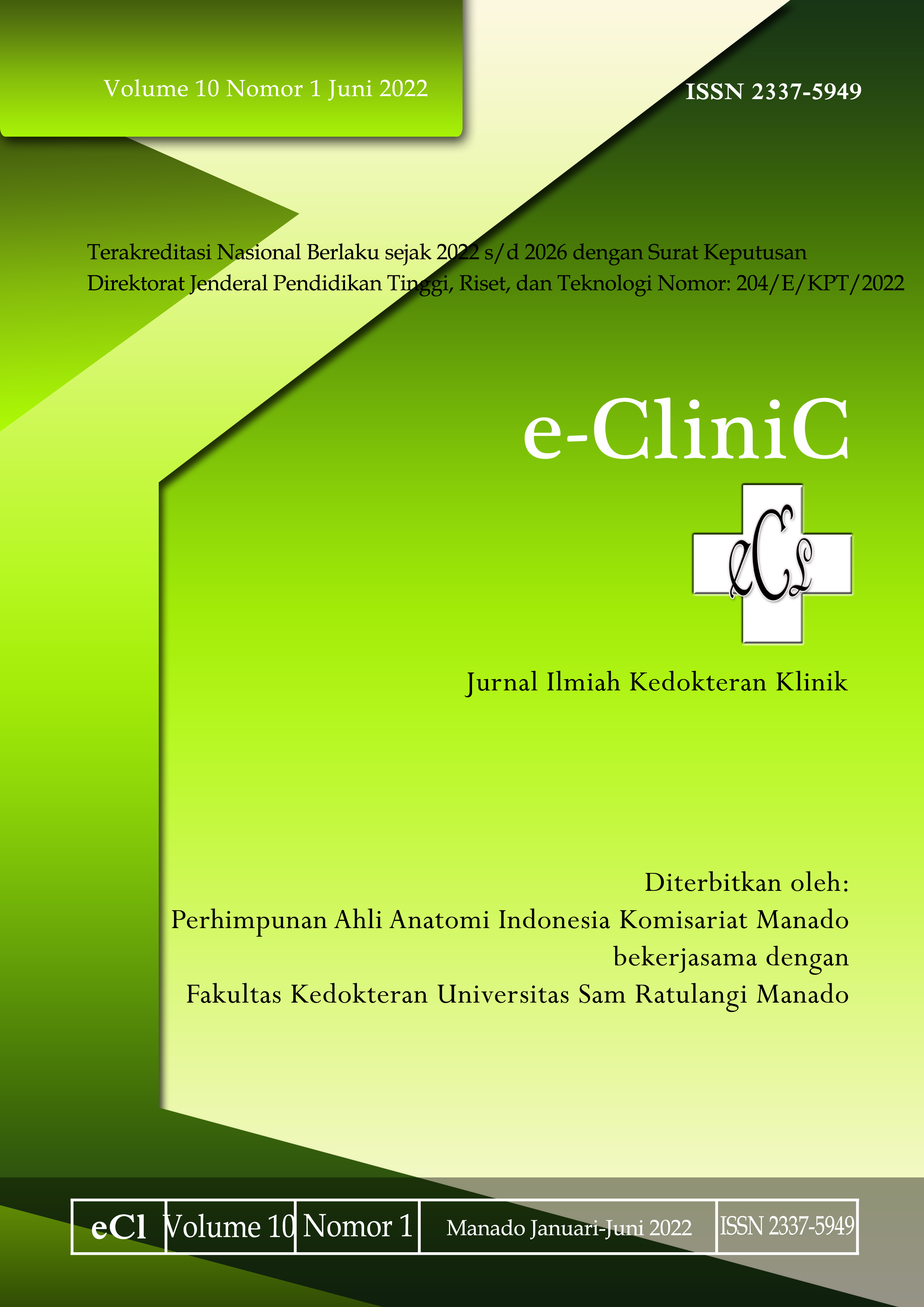Formation of SARS-CoV-2 Specific Antibody after vaccination
DOI:
https://doi.org/10.35790/ecl.v10i1.37193Abstract
Abstract: Vaccination is considered as the most effective solution for the SARS-COV-2 pandemic problem. Therefore, an understanding of the effectiveness of vaccination is now very important, both to design a better response to SARS-CoV-2, as well as to provide education for prospective vaccination participants. This study was aimed to obtain the description of specific antibody in SARS-CoV2 vaccinated individuals. This was a cohort-design study. SARS-CoV-2 specific antibody was measured wiht the Electro Chemiluminescence Immunoassay (ECLIA) method. This study was carried out at Prof. Dr. R. D. Kandou Hospital with 28 subjects; all were examined three times with an interval of three weeks. The first antibody examination revealed antibody formation (IgG) with a range of 3.6-1825 AU/mL with a median of 418.3 AU/mL and a mean of 525.6 AU/mL. In the second and third examinations, the median antibody titer value in the elderly group was recorded at 482.9 AU/mL and 631.3 AU/mL respectively, which were higher than the group of non-elderly subjects who were recorded to have a median of 391.9 AU/mL in the second examination and 401.6 AU/mL in the third examination. In conclusion, vaccination causes specific immunity, and the effectiveness of vaccination for the formation of specific antibodies (IgG) in the elderly group is good, although it takes a longer time compared to the non-elderly group. Moreover, the antibody formed after 63 days from the first vaccination in the elderly group is higher than in the non-elderly group.
Keywords: SARS-COV-2; antibody; vaccination
Â
Abstrak: Penanggulangan pandemi SARS-COV-2 yang dianggap paling efektif hingga saat ini ialah vaksinasi, yang dilengkapi dengan penerapan protokol kesehatan. Pemahaman tentang efektivitas vaksinasi saat ini menjadi amat penting, baik untuk merancang penanggulangan SARS-CoV-2 yang lebih baik, maupun untuk memberikan edukasi bagi calon peserta vaksinasi. Penelitian ini bertujuan untuk mendapatkan gambaran antibodi spesifik yang terbentuk pada penerima vaksinasi SARS-CoV2 menggunakan desain cohort. Pengukuran antibodi spesifik SARS-CoV-2 menggunakan metode Electro Chemiluminescence Immunoassay (ECLIA). Penelitian dilaksanakan di RSUP Prof. Dr. R. D Kandou dengan jumlah subjek 28 orang, masing-masing diperiksa tiga kali dengan jeda waktu tiga minggu. Pada pemeriksaan antibodi pertama ditemukan pembentukan antibodi (IgG) dengan range 3,6-1825 AU/mL dengan median 418,3 AU/mL dan rerata 525,6 AU/mL. Pada pemeriksaan kedua dan ketiga, nilai median titer antibodi pada kelompok lanjut usia, berturut-turut tercatat 482,9 AU/mL dan 631,3 AU/mL pada pemeriksaan ketiga, lebih tinggi dibanding dibanding kelompok subjek non lansia yang tercatat memiliki median 391,9 AU/mL pada pemeriksaan kedua dan 401,6 AU/mL pada pemeriksaan ketiga. Simpulan penelitian ini ialah vaksinasi menimbulkan imunitas spesifik, dan efektivitas vaksinasi untuk pembentukan antibodi spesifik (IgG) pada kelompok lanjut usia baik, walau membutuhkan waktu yang lebih panjang dibanding kelompok non lanjut usia. Antibodi yang terbentuk pasca vaksinasi 63 hari setelah pemberian vaksinasi pertama pada kelompok lanjut usia lebih tinggi dibanding kelompok non usia lanjut.
Kata kunci: SARS-CoV-2; antibodi; vaksinasi
Downloads
Additional Files
Published
How to Cite
Issue
Section
License
COPYRIGHT
Authors who publish with this journal agree to the following terms:
Authors hold their copyright and grant this journal the privilege of first publication, with the work simultaneously licensed under a Creative Commons Attribution License that permits others to impart the work with an acknowledgment of the work's origin and initial publication by this journal.
Authors can enter into separate or additional contractual arrangements for the non-exclusive distribution of the journal's published version of the work (for example, post it to an institutional repository or publish it in a book), with an acknowledgment of its underlying publication in this journal.
Authors are permitted and encouraged to post their work online (for example, in institutional repositories or on their website) as it can lead to productive exchanges, as well as earlier and greater citation of the published work (See The Effect of Open Access).







